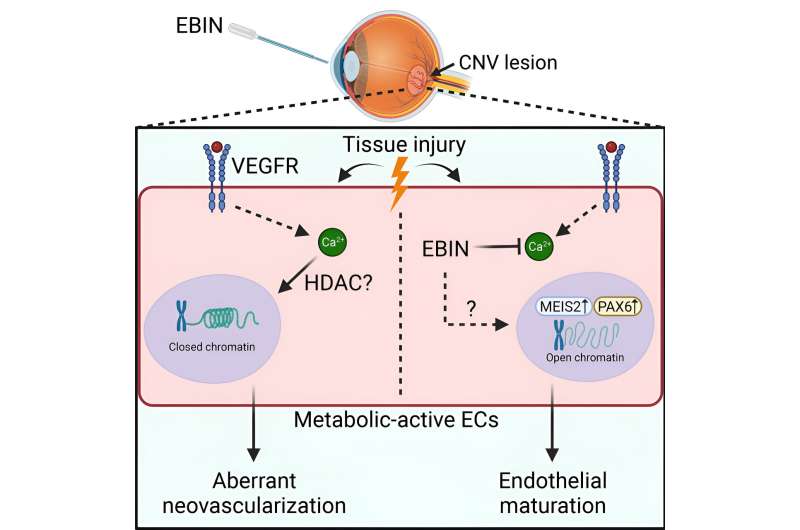This article has been reviewed according to Science X's editorial process and policies. Editors have highlighted the following attributes while ensuring the content's credibility:
fact-checked
peer-reviewed publication
trusted source
proofread
New strategy for eye condition could replace injections with eyedrops

A new compound developed at the University of Illinois Chicago potentially could offer an alternative to injections for the millions of people who suffer from an eye condition that causes blindness.
Wet age-related macular degeneration causes vision loss due to the uncontrolled growth and leakage of blood vessels in the back of the eye. A new paper in Cell Reports Medicine led by UIC researcher Yulia Komarova finds that a small-molecule inhibitor can reverse damage from AMD and promote regenerative and healing processes.
The drug can also be delivered via eyedrops—an improvement over current treatments for AMD, which require repeated injections into the eye.
"The idea was to develop something that can be more patient-friendly and doesn't require a visit to the doctor's office," said Komarova, associate professor of pharmacology at UIC.
Komarova's compound targets a protein called End Binding-3 in endothelial cells, which line the inside of blood vessels. In the new study, the researchers looked at whether inhibiting EB3 function could stop the damaging leakage associated with wet AMD.
Using computational drug design methods, the team developed a small inhibitor that could be delivered externally via eyedrops instead of by injection. They then tested its effectiveness in animal models of wet AMD, finding that twice-daily treatment reduced eye damage within 2 to 3 weeks.
Further investigation found that the inhibitor worked by rolling back aging-related genetic modifications. Aging causes inflammation and hypoxia in the eye that leads to changes in gene expression associated with the cellular effects and symptoms of wet AMD. Komarova and colleagues found that the EB3 inhibitor they developed reversed these epigenetic changes, restoring gene expression to a normal, healthy state.
"We reduce the effects of the stressor on endothelial cells and we improve regenerative processes, accelerating healing," Komarova said. "That can be tremendous for the function of the cells."
Because blood vessel leakage and hypoxic stress also drive many other medical conditions, Komarova's group is interested in testing the inhibitor in models of acute lung injury, diabetic retinopathy, stroke, heart disease and even the general effects of aging on the brain. They're also exploring whether an implantable lens, similar to a contact lens, could deliver the drug to the eye more effectively than eyedrops.
More information: Quinn Lee et al, End binding-3 inhibitor activates regenerative program in age-related macular degeneration, Cell Reports Medicine (2023). DOI: 10.1016/j.xcrm.2023.101223



















